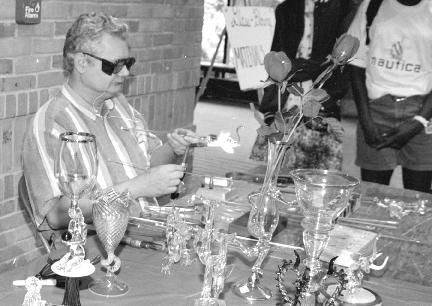The University Record, August 13, 1997
|
|
Harald Eberhart, master glassblower in the College of Engineering, demonstrated glassblowing techniques for secondary students at the third annual Summer Engineering Academy Aug. 7. Photo by Bob Kalmbach |
By Kerry Colligan
Last week, 145 high school and middle school students attended the third annual Summer Engineering Academy’s (SEA) Engineering Expo, sponsored by the Minority Engineering Programs Office (MEPO). The Expo featured 21 exhibits from various engineering disciplines.
Students lined up to try on virtual reality glasses at the “Virtual Chemical Engineering” display. Participants watched a chemical reaction-the formation of gasoline-as James Angelo, a graduate student in chemical engineering, explained how the reaction t akes place.
“The glasses are a fabulous learning tool,” Angelo told the students. “They allow us to easily see what we can otherwise only see under a microscope.”
Richard Woods, chair of the civil engineering department, drew a crowd with his “Quick Sand Tank.” Woods explained to students what factors engineers consider when building on “soft” ground. Students were then invited to feel the sand compress around thei r hands.
“It’s pretty cool,” said Akin Oni-Orisan, an 8th-grade student from Ypsilanti, after pulling his hand from the sandy water.
SEA participants spend eight weeks on campus attending classes in math, engineering concepts, communication skills, computer skills, and cultural concepts. They work on inter-disciplinary projects, learning the range of tasks in which engineers are invol ved, and focusing on ethical responsibilities and team building.
“Engineering develops your critical thinking skills,” said Emily Wu, a junior at Ann Arbor Huron High School who plans to study biomedical engineering at U-M. “It will give me a big advantage in medical school,” she added.
“We’re trying to give them a broad perspective on how engineers impact society, rather than algebraic formulas and the like,” said Darryl Koch, curriculum coordinator for SEA. “We’re trying to give them the tools to succeed in the 21st century.”
Derrick Scott, director of MEPO, says the program has been successful in preparing participants for college. Approximately one-half of the participants in the upper high school grades progress to pursue engineering, math or science-related degrees, many o f them at U-M. Prior to restructuring the program three years ago, there were approximately 200 students of color enrolled as entering freshman in the College of Engineering. This fall, Scott says, the College expects approximately 600.
Making science fun might be the most important factor in the program’s success. “We’re always looking for ways to show the kids what we do,” says Scott.
Takiyah Bussey, a 9th-grader at Cass Tech High School in Detroit, says she came to SEA because she thought it would be fun. “It’s been fun, but we’re learning a lot too. They’re teaching us to speak more fluently so we can communicate our ideas better. We ‘re learning formulas, engineering concepts, and living with other students. I’m meeting new people and working on projects with real problems, not just numbers,” Bussey says.


